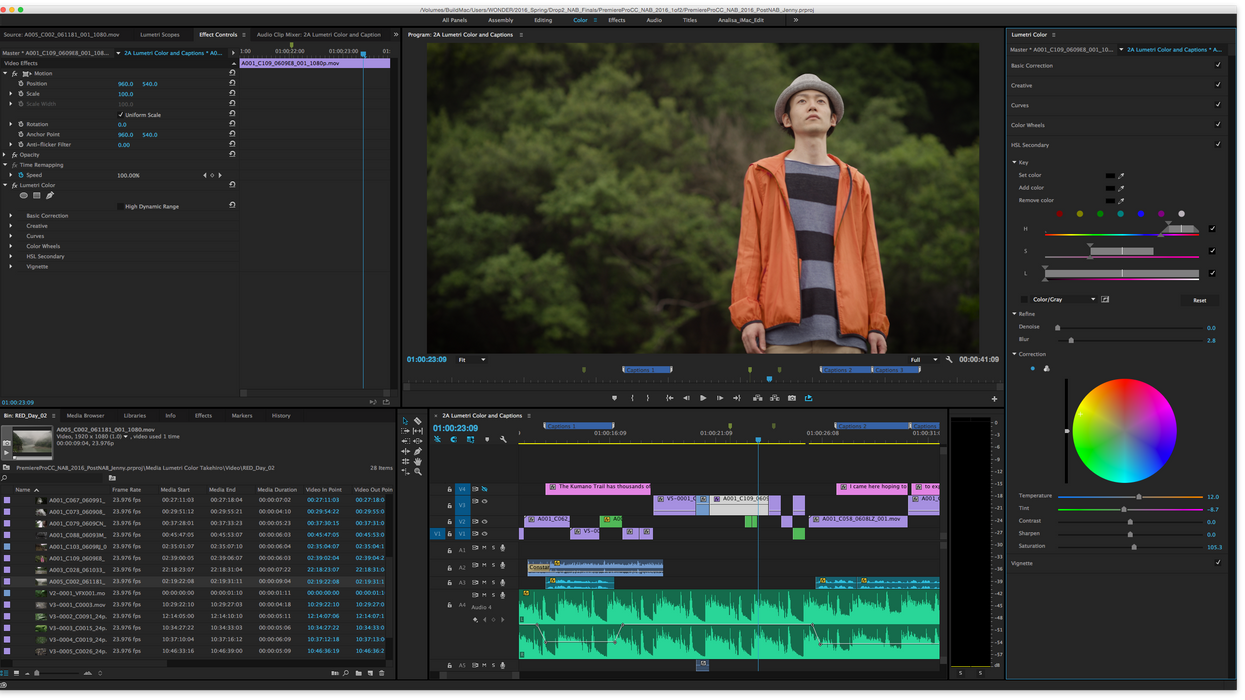Dive into Premiere Pro: Adobe's Obsession with Color
Adobe Premiere Pro puts editing and color grading into one seamless program.

[Editor's note: In this series, we will be exploring Adobe's approach to several aspects of post-production, and how Creative Cloud can help elevate your work.]
Filmmakers know that color is one of the most powerful storytellers, and being able to control the grade of a film is tantamount to being able to tell better, richer, and more profound stories. For quite some time, filmmakers have desired a tool that could combine the worlds of editing and color grading into one seamless program, and Adobe Creative Cloud solves many of the issues facing editors of all experience levels with powerful and intuitive video and color tools in Premiere Pro, including new color options, optimized layout design, and single-click professional looks inside the Lumetri panel.
We spoke with Patrick Palmer, Product Manager for Premiere Pro, about all of the high-quality color options the program has to offer, as well as the ideas and thought processes that went into turning Premiere Pro into the creative powerhouse that it has become today.
"In the 80s, when it was all tape-to-tape, it was unthinkable that a workstation would give you editing and color grading."
New color tools
Adobe has essentially combined two post-production programs, non-linear editing and color grading, into one. According to Adobe, the color and light tools, which came from its legacy tool Adobe SpeedGrade CC, are designed to give users more power and control over color without ever having to leave Premiere Pro. Users can now work with new curves, including RGB and Hue/Saturation, as well as color tools that adjust midtones, shadows, and highlights—all within the Lumetri Color panel.
LUTS, looks, and presets
Another big addition to Premiere Pro is the new LUT functionality, which gives users the power to apply professional looks with a single click, as well as preview them right inside the Lumetri panel. Not only that, but users can easily save and reuse their LUTs, looks, and presets in different projects or applications by exporting them as a .Look file or LUT file.
More dynamic workflow
According to Palmer, the interface is one of the most important aspects of the upgrade, because it changes the user experience so dramatically. Designed in "the spirit of Lightroom," this new interface makes using color tools more accessible and approachable by providing a panel with easy-to-use sliders, checkboxes, and other options, allowing users to work faster and more efficiently. No more jumping back and forth between multiple programs; Premiere Pro has everything you need to edit and color grade your footage in one program.
"In some of these editing programs, they have buttons that look like they could fly you to the moon and back!"
Easy enough for beginners, powerful enough for pros
Regardless of whether you're a beginner or a seasoned pro, Premiere Pro caters to your needs. Palmer says, "Too many people shy away from high-end software because there are too many tools. They just do what's easy." However, he asserts, Premiere Pro gives you both: tools that are easy enough for a beginner to get started and the option for experienced users to dig deep into color with scopes, curves, and HSL secondaries all within the same program.
Palmer adds, "In some of these editing programs, they have buttons that look like they could fly you to the moon and back! For people that want to fly to the moon, there are definitely tools out there for them. For people that maybe just want to fly to Costa Rica, we’ve got plenty of powerful tools that can get you there."
Be your destination the moon or Costa Rica, you're still going to fly in the same plane the whole trip. That is one of the greatest new aspects of Premiere Pro: being able to edit and grade footage all in the same place without having to interrupt your workflow. Palmer acknowledges that this feature comes out of an existing need from previous versions. "There is a moment of distraction when switching between different applications, " he says. Using Premiere Pro is a better experience because it "creates interconnectivity and allows you to focus without any friction. You don't have to change your mindset."
If you want to learn more about how to put Premiere Pro's new color tools to work on your own projects, check out Adobe's online training session that teaches you how to make your videos even better with color. It's a three-part course that will be hosted at 9am (PST) on Adobe Creative Cloud's Facebook page on January 19, 2018 and January 26, 2018.
See all parts of this series:
Dive into Premiere Pro: Dynamic Tools Make Motion Graphics Easy
Dive into Premiere Pro: Adobe's Obsession with Color













